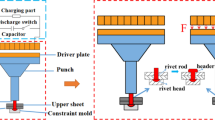Abstract
Molds, which are used for largeingot castings, are operated under severe conditions that combine cyclic temperature loads with the mold metal interactions during mold filling. The paper presents a study of the main technological aspects that affect the durability of large octagonal ingot molds weighing 13000 kg with a wall thickness of 210–270 mm made of pig iron. An assessment of the liquid steel flow distribution in the ingot volume during the bottom casting and the features of their interaction with the walls of the mold was made by using mathematical modeling. The studies were carried out on the effect of vibration treatment on the physical and mechanical characteristics of blast furnace pig iron castings of various weights. It was shown that vibration treatment in a certain frequency range can provide an increase in the pig iron tensile strength and hardness by an average of 20–25% and fluidity by an average of 1.5–1.8 times. Application of an experimentally established vibration treatment mode in the production of industrial molds for 10000 kg ingot castings increased their durability by an average of 16–17%.










Similar content being viewed by others
References
T. Nishimura, A. Kishimoto, Casting defect analysis of carbon steel using sand casting experiments. Int. J. Metalcast. 17, 2030–2037 (2023). https://doi.org/10.1007/s40962-022-00917-3
Q. Cai, Z. Chen, C. Xu, W. Pinjun, H. Bokui, D. **aozhou, Effect of elemental segregation on the microstructure and mechanical properties of heavy section compacted graphite iron. Int. J. Metalcast. 17, 222–232 (2023). https://doi.org/10.1007/s40962-022-00758-0
Y. Tanaka, I. Sato, Development of high purity large forgings for nuclear power plants. J. Nucl. Mater. 417(1–3), 854–859 (2011). https://doi.org/10.1016/j.jnucmat.2010.12.305
M. Geerdes, H. Toxopeus, C. van der Vliet, Modern blast furnace ironmaking: An introduction, 2nd edn. (IOS Press BV, Amsterdam, 2009)
D.H. Wakelin, R.J. Fruehan, The making, sha**, and treating of Steel 11th Edition: Ironmaking volume. (The AISE Steel Foundation, 1999), p. 811
R. Dwulat, K. Janerka, Evaluation of the metallurgical quality of nodular cast iron in the production conditions of a foundry. J. Manuf. Mater. Process. 7(1), 18 (2023). https://doi.org/10.3390/jmmp7010018
V. Efremenko, K. Shimizu, T. Pastukhova, Y. Chabak, M. Brykov, K. Kusumoto, A. Efremenko, Three-body abrasive wear behaviour of metastable spheroidal carbide cast irons with different chromium contents. Int. J. Mater. Res. 109(2), 147–156 (2018). https://doi.org/10.3139/146.111583
O.E. Markov, O.V. Gerasimenko, V.V. Kukhar, O.R. Abdulov, N.V. Ragulina, Computational and experimental modeling of new forging ingots with a directional solidification: the relative heights of 1.1. J. Braz. Soc. Mech. Sci. Eng. 41, 310 (2019). https://doi.org/10.1007/s40430-019-1810-z
G. Yu, V. Chabak, G. Efremenko, Change of secondary-carbides’ nanostate in 14.5% Cr cast iron at high-temperature heating. Metallofiz. Noveishie Tekhnol. 34(9), 1205–1220 (2012)
J. Campbell, Effects of vibration during solidification. Int. Metals Rev. 26(1), 71–108 (1981). https://doi.org/10.1179/imtr.1981.26.1.71
J. Campbell, Castings (Butterworth-Heinemann, Oxford, 1993)
F. Menter, Zonal two equation k-ω turbulence models for aerodynamic flows, AIAA Journal (1993)
A. Smirnov, V. Ukhin, S. Semiriagin, A. Semenko, Y. Skorobagatko, Simulation of the fluid flow in continuous casting copper slab mold for different SEN design. Metall. Res. Technol. 121(1), 106 (2024). https://doi.org/10.1051/metal/2023088
J. Yin, M. Ersson, H. Mao, P.G. Jönsson, Mathematical modelling of the initial mold filling with utilization of an angled runner. Metals 9(6), 693 (2019). https://doi.org/10.3390/met9060693
Acknowledgements
The research was supported by the National Academy of Sciences of Ukraine (No. 0122U000617).
Author information
Authors and Affiliations
Corresponding author
Ethics declarations
Conflict of interest
The authors declare that they have no conflicts of interest in this work.
Additional information
Publisher's Note
Springer Nature remains neutral with regard to jurisdictional claims in published maps and institutional affiliations.
Rights and permissions
Springer Nature or its licensor (e.g. a society or other partner) holds exclusive rights to this article under a publishing agreement with the author(s) or other rightsholder(s); author self-archiving of the accepted manuscript version of this article is solely governed by the terms of such publishing agreement and applicable law.
About this article
Cite this article
Smirnov, O., Ukhin, V., Goryuk, M. et al. Evaluation of the Possibilities for Improving Durability of Large Ingot Molds Made of Pig Iron Using Vibration Treatment of the Melt. Inter Metalcast (2024). https://doi.org/10.1007/s40962-024-01390-w
Received:
Accepted:
Published:
DOI: https://doi.org/10.1007/s40962-024-01390-w




